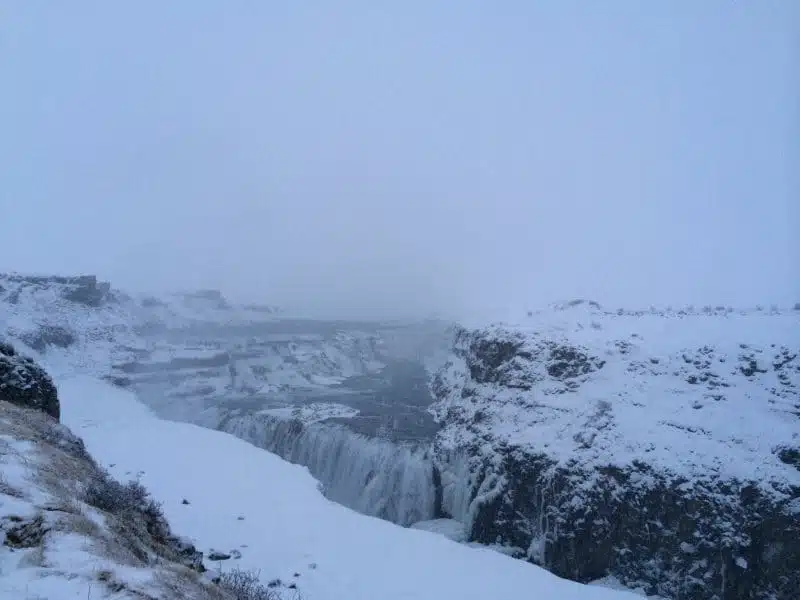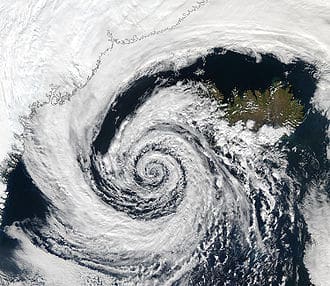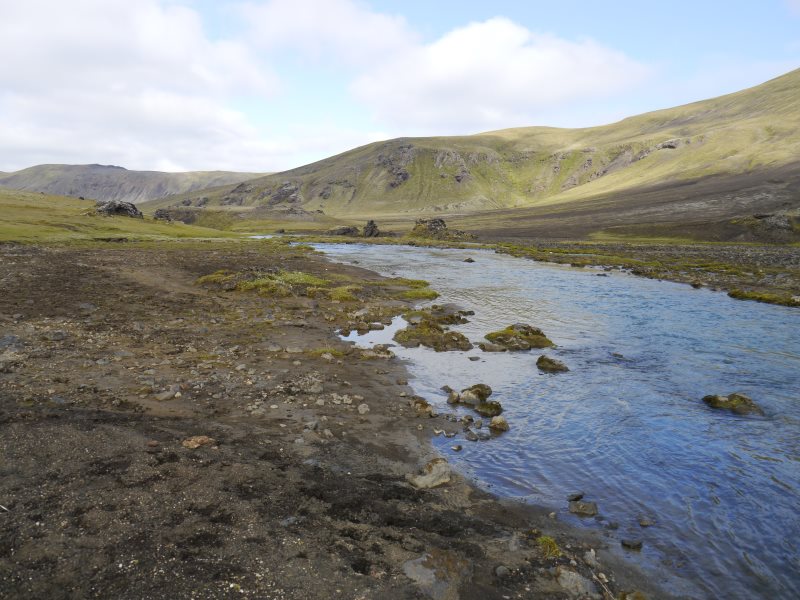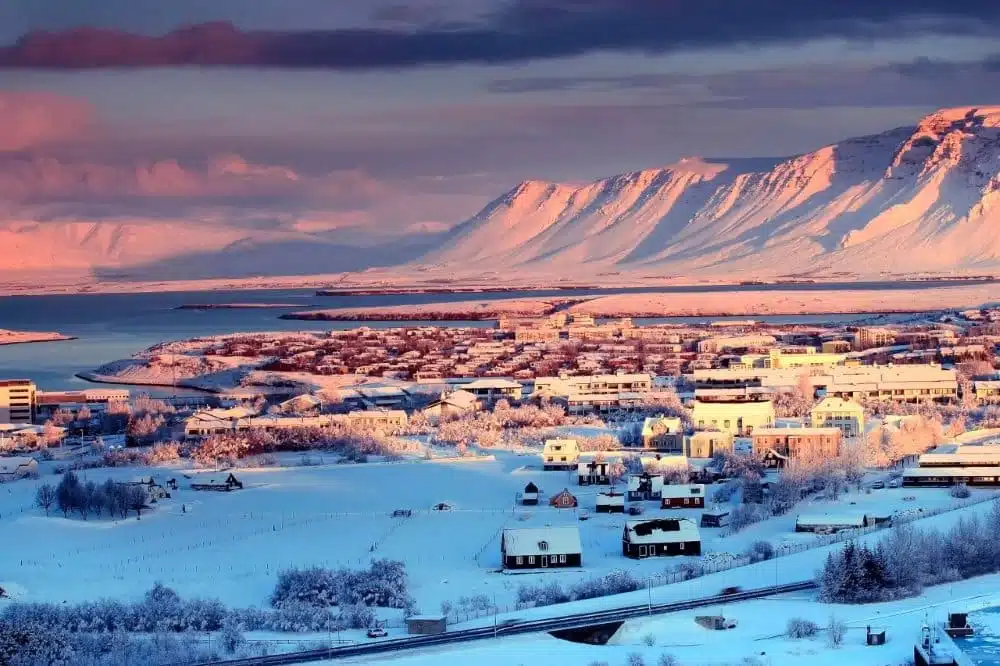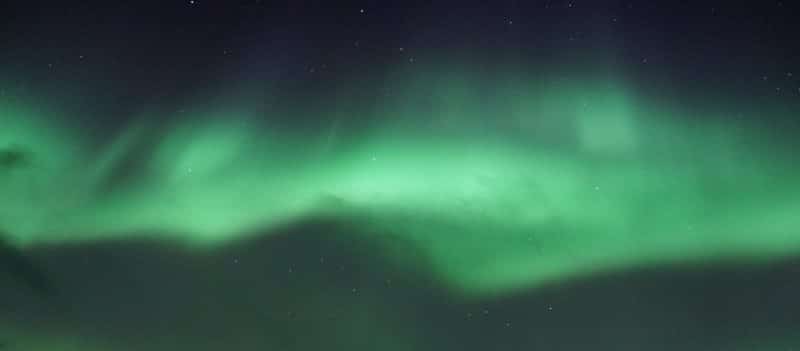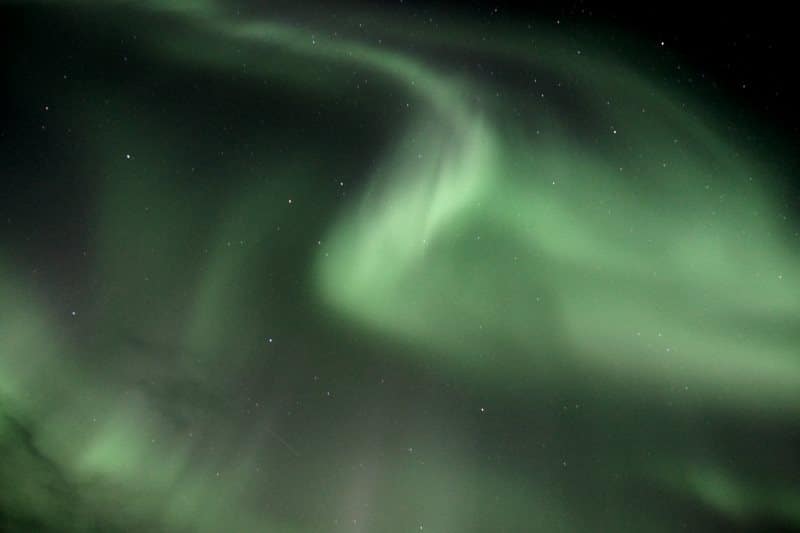With its location close to the Arctic Circle, in the middle of the North Atlantic, Iceland should have a harsh climate, especially in the winter. However, the presence of the famous Gulf Stream marine current softens the temperatures, especially near the coasts, even if the climate is much harsher in the interior because of the geography of Iceland and its relief.
General characteristics
The Icelandic coast has a temperate oceanic climate (Köppen classification of Dfc type), while the highlands of this country know a much harsher climate of Tundra type, continental (on certain zones protected from the maritime influence) or even polar (on the inlandsis and the glaciers).However, if there is indeed a principal character of the Icelandic climate, it is its persistent freshness (seldom more than 15°C) and especially
its great variability and instability! Indeed, the presence of a warm current from the southwest to the northeast (the Irminger current) and a cold current (the Greenland current) to the north of the island, as well as its location not far from the polar air masses of the Arctic and the mild and humid Atlantic, cause the creation of a low-pressure minimum near the island and therefore many storms and precipitations. On the program, you will have the right to many changes of weather during the same day as well in terms of temperatures as precipitation or cloudiness (even if the weather is often cloudy).
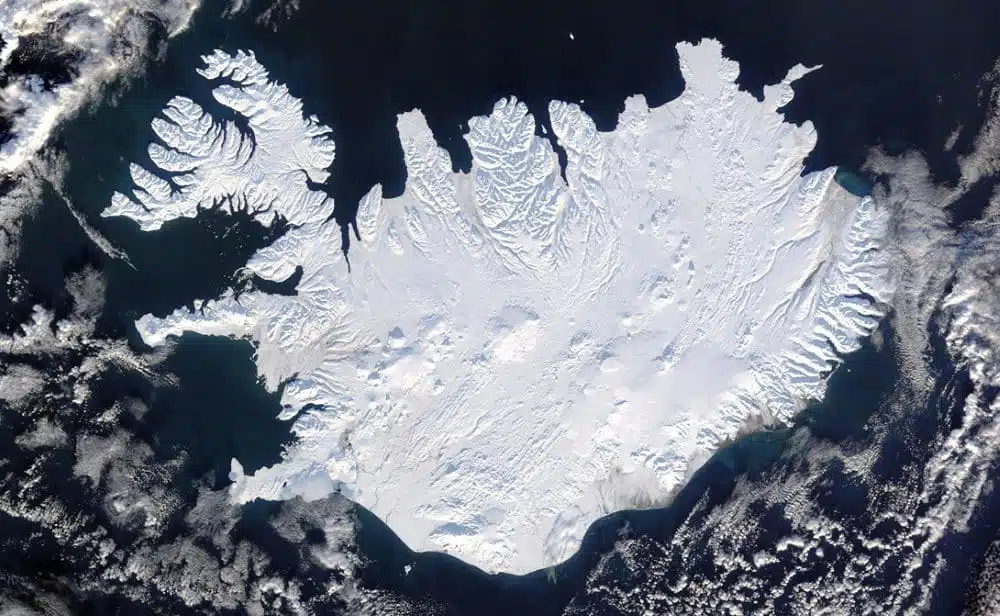
Temperature
First point when we are interested in the climate of Iceland, we look at the temperatures. These are cool, even in summer, not exceeding 15°C on average. In winter, at least on the coasts, temperatures rarely go below -2°C on average (average minimum and maximum of the day). There is therefore little variability in temperature in Iceland, except inland where it can be as low as -10°C in winter for a similar summer temperature.
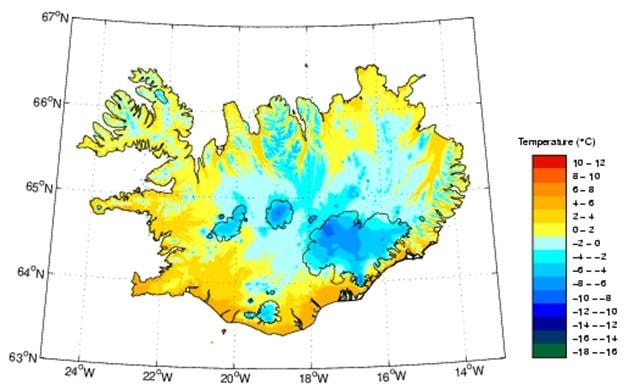
During the same day, temperatures vary little, with only a few degrees between morning and afternoon.
As far as temperatures are concerned, the coldest on the coast are in the north, for example in Akureyri, and they are much milder on the south coast. In summer, some fjords in the East and North also experience quite high temperatures, with the thermometer rising to as much as 20 to 25°C on certain days…
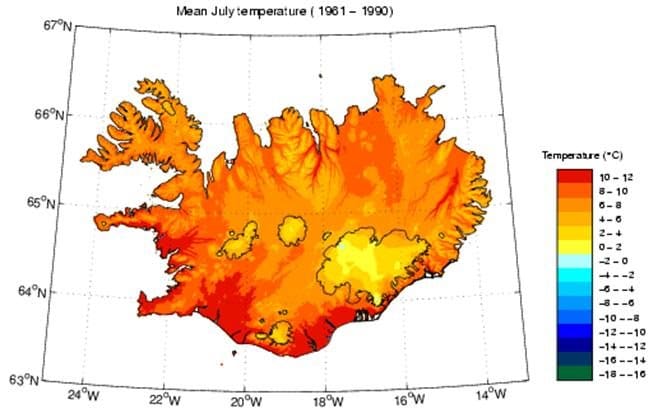
The record temperatures were -39.7°C at Grímsstaðir in Fjöllum (North of the country) and 30.6°C at Teigarhorn (East Fjord). For Reykjavik, the maximum temperature is 25.7°C and a minimum of -19.7°C. In Akureyri, the differences are more obvious with -23°C and +29.4°C.
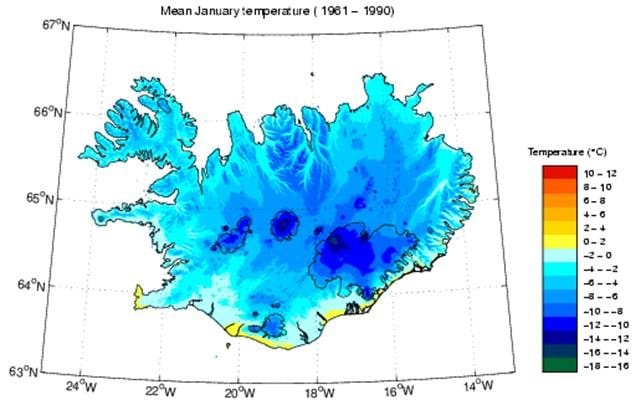
Climate data of Reykjavik
Climate data of Akureyri
Precipitation
Close to one of the lowest pressure zones in the world, Iceland is a place where many depressions form and circulate, which then reach Europe. This situation causes wind and also a lot of precipitation.
Concerning the precipitations, they are in general very numerous as we can see it with this map. The largest quantities are found in the southern regions of the country, as well as in the southeast and west (including the northwestern fjords). It is on the reliefs and the main glaciers that we find the most important precipitations with more than 2000 mm. Some areas, such as Vatnajökull, Eyjafjallajökull, Mýrdalsjökull or Langjökull, even reach very high amounts with more than 4000 mm per year!
On the contrary, some areas are almost steppe-like, like the plateaus north of Vatnajökull which receive less than 600 mm, or even 400 mm. This area is indeed subject to foehn winds, with the moisture flowing over the mountain and the air mass drying out.
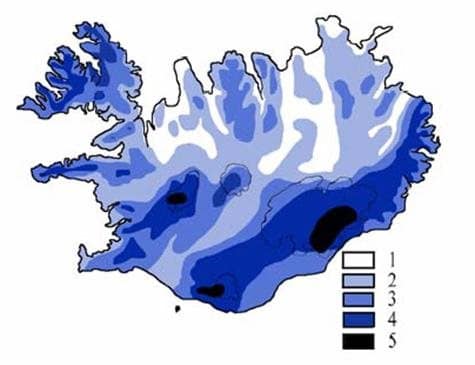
It rains the most between October and January, and the least between April and June, both in terms of quantity and number of days.
Concerning the two biggest cities of the country, Reykjavik is quite sheltered from precipitations with about 800 mm and 150 days of rain and snow (against more than 1000 mm in the surroundings). Akureyri is even more protected, with only 490 mm and 102 days of precipitation. In the small municipality of Vík í Mýrdal in the south of the country, the precipitation is much more impressive with 2273 mm.
In winter, precipitation is often snow and rain mixed on the coasts and is almost exclusively snowy inland. As for thunderstorms, they are extremely rare, with less than five days per year, mainly in late summer.
Winds
The lows that circulate over Iceland or near the country cause winds that are often violent and almost daily. As the island is not far from the heart of the lows, the winds often turn with great importance from the east, northeast and west and northwest sectors. Of course, the wind can vary according to the topography of the place and the altitude.
Concerning the strength of the wind, it can be very violent during the big storms which take place mainly in winter or in summer (ex tropical cyclone which goes up the Atlantic). But the wind is not only strong, because Icelanders have 8 denominations for the different wind forces, from logn (weak) to rok (strong).
The most exposed areas are the coasts (northwest, west and south) and also the highlands, including the plateaus north of Vatnajökull or in the south, which are subject to the powerful foehn effect and katabatic winds. The Icelandic foehn wind forms when precipitation is blocked on one side of the mountain. The air rises, dries out and warms up, then falls back down the slopes of the glacier. He then finds immense plains of ash without relief, nor tree to slow him down. This dry wind is turbulent and not very bearable. The cabatic wind is quite similar to the foehn, except that it is a cold air current.
In early summer, sandstorms can also occur in the north, but also in the southern sandur areas. During these events, tons of material (sand and ash) can be transported at high speed and cause damage.
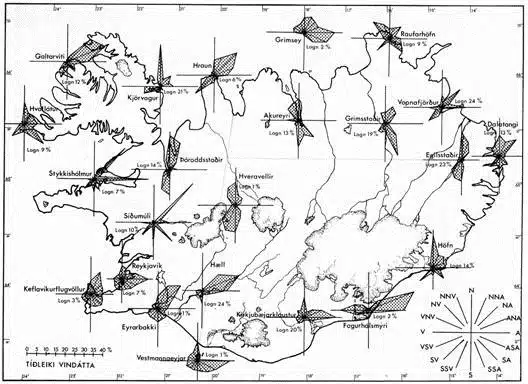
Cloudiness
The island is surrounded by water and in an often disturbed area, so the climate in Iceland is quite cloudy. Rare are the days without any clouds, but also the days totally blocked because the fog is rather rare (thanks to the wind) and that the weather changes often. Most of the days will therefore see alternating clouds, sun, rain, etc.
Concerning the number of hours of sunshine, the data for Akureyri are 1042 hours, which is low (1692 hours in Paris, 2917 hours in Toulon). For Reykjavik, it is a little better with 1268 hours. The sunshine is more important on the dry plateaus of the north center.
The different seasons
As with all countries above the tropics, Iceland has four seasons in its climate. However, in this very oceanic country, the seasons are not necessarily very marked, because the winter is not excessively cold (especially if you look at the latittude) and the summer is very cool.
- In spring, Iceland slowly comes out of the winter torpor as the days go by, even if the snow is still largely present. The sun is becoming more and more generous, only setting for a few hours at the end of May. Storms, as well as rain, tend to subside.
- Summer is the most pleasant season in Iceland, even if temperatures rarely exceed 15°C on average, with rare peaks around 25 or 30°C in the hottest places (northern and eastern fjords). It generally rains regularly, but less than in winter or in the autumn, and the sun is also relatively generous.
- The autonomy sees the arrival of storms, snow (sometimes on the coasts from the end of September!). With the decrease of the luminosity, the temperatures drop little by little and the frosts reappear.
- Winter is logically the coldest season, minimum temperatures are close to 0°C near the coasts and much lower as soon as you go inland. However, rain is not rare, especially in Reykjavik as the lows pass. In any case, the weather is very changeable.
Aurora Borealis and midnight sun
Two spectacular and very common phenomena in Iceland are related to the sky. These are the northern lights and the midnight sun.
Being very close to the Arctic Circle, Iceland has very short nights around June, or even none at all on the island of Grimsey (extreme north). Even in the south, the nights can reach 20 or 22 hours in June. On the program: the midnight sun and the splendid lights that go with it!
With the arrival of the autonomous, the days shorten very quickly, and in December one counts only 1 to 4 hours of sun per day according to the areas. It is during this time of the year that the magnificent Northern Lights appear in Iceland. This phenomenon is created by the solar winds that carry particles. These, while entering the magnetosphere, then the atmosphere, will meet oxygen and nitrogen atoms and cause immense auroras with multiple colors and forms. To see them, it is better to move away from the cities, to wait for the night to fall and the sky to be clear.
When to go to Iceland
The Icelandic climate is therefore difficult and the weather very changeable, but when should you leave for this island of a thousand beauties? You can find more information on :
- When should I go to Iceland? During which seasons? What to see depending on the month you go to Iceland?
- Iceland weather to know the weather, because the weather changes very quickly in this country!

